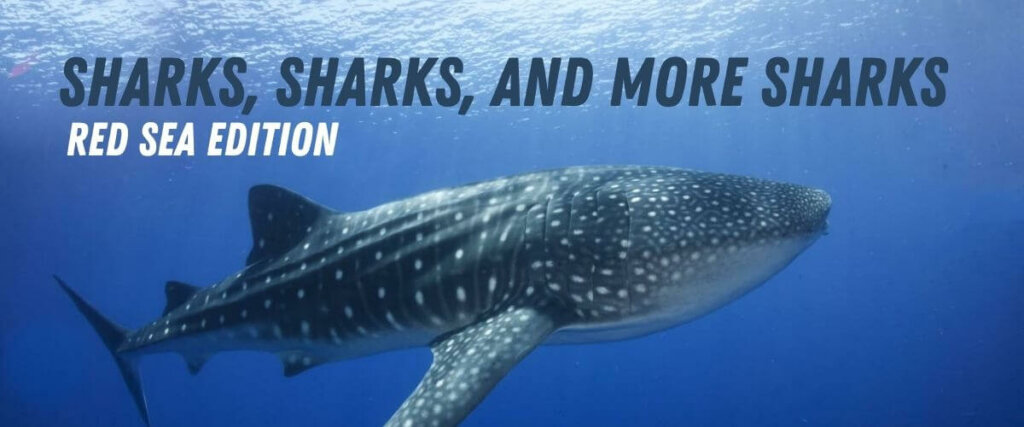Shark week is all about creating awareness and changing perspectives on what sharks are all about and how important they are to the health of our planet.
The Red Sea is one of the most incredible and diverse tropical reef systems on earth and hosts an array of Shark species.
Diving every day allows us to see these beautiful creatures in action, watch their behaviors, and monitor sightings throughout the year.
We have put together some interesting facts about our Red Sea shark species and when/where you could spot them here in Sharm El Sheikh.
Whale Shark (Rhincodon typus):
Number one on a divers bucket list. The whale shark is slow swimming, filter-feeding giant, and the largest of the shark species. The Saudi Arabian Red Sea is now known to be a significant hotspot for juvenile whale shark aggregation. Being so close, we see these gentle giants regularly from spring and throughout the summer. Your best chance of a sighting is between April and August. They are migratory and travel immense distances. Sightings here range from Tiran, along the coast, Ras Mohammed, the SS Thistlegorm, and beyond. Most of our sightings are young whale sharks averaging around 4-6 meters in length. We have had many incredible experiences with Whalesharks in Marsa Bareika, Ras Zatar. We had an unforgettable encounter on the Shark Reef wall where a shark came up head first from the deep with its mouth open wide, truly magical.
White Tip Reef Shark (Triaenodon obesus):
White Tip reef sharks are most active at night and are one of the few sharks that you are likely to encounter resting on the bottom or gathered together in small caves. Most sharks need to keep moving to breathe Whitetips actively pump water over their gills when at rest. Here in Sharm, you can find them throughout the year relaxing on sandy spots in Ras Mohammed, Tiran, and on the local sites. Sites like Gordon, Thomas, Jackfish Ally, Ras Zatar, Shark Observatory, Shark & Yolanda, Near Garden, Ras Camilla, Ras Umm Sid, and Ras Katy are particular hot spots for this residential species.
Scalloped Hammerhead shark (Sphyrna lewini):
The strangest-looking shark found here in the Red Sea. The distinguishing factor of a hammerhead shark is the hammer-shaped head and extra-long dorsal fin. It is a shy shark that spends most of its life alone. We are lucky enough to be able to witness their gatherings here in Sharm. Tiran is most famous for these gatherings. Sightings of anything from 5 to 40 of these majestic creatures out in the blue on the back of Jackson reef.
Most encounters will start with divers waiting patiently off the reef for a sharky shape to come out of the depths. A Hammerhead scout is usually spotted first, checking out the situation, then the scout will be joined by others the numbers will grow from there.
‘Hammer-time’ in Sharm El Sheikh is usually during the summer and late autumn months when the water is warmest from June to November. Lone adults are seen in Ras Mohammed and along the coast. Tiran is a hotspot during peak times.
Black Tip Shark (Carcharhinus limbatus):
A Red sea shark sighting for the logbook! These are rare sightings being pelagic hunters spending most of their time out in the big blue. They come to our reefs in the summer, where large groups of fish like the Snappers, Batfish, Spangled Emperors, pick-handle barracuda, and unicornfish get together to spawn. Shark and Yolanda Reef is the most commonplace for these agile hunting machines. The stronger currents here draw many fish aggregations creating an ‘all you can eat buffet’ Usually actively hunting when sighted, with as many as three together at a time smashing into schools of barracuda or snapper. Jackfish Ally and Ras Zatar are also known for Black Tip sightings due to converging currents that draw large numbers of fish.
Thresher Shark (Alopias pelagicus):
Eyes like coal, a tail twice the length of its body, and the most amazing shiny, gunmetal grey colour, these impressive sharks hunt by stunning their prey with a whip of the tail. This cryptic shark is a rare find for divers and comes in the Summer around Tiran and Ras Mohammed. Though they usually don’t come close to the reef and head away from divers, however, a bold Thresher may investigate and give divers a sighting of a lifetime.
Oceanic Whitetip (Carcharhinus longimanus):
Probably the most infamous shark species found here in the Red Sea. Characteristic white tips on their fins, a slow swimming style due to their wide pectoral fins make it easy to identify this shark along with the entourage of pilot fish. It is a solitary shark that is always on the lookout for its next meal. Divers have seen the Oceanic White Tip in almost all of the dive sites here in Sharm. They arrive while the water is warmest from May to November when there is plenty of big fish like barracuda, snapper, and tuna fish. They are one of the few shark species that you will see at the surface. More they are spotted by divers from the boat on the surface interval. A very bold shark that will approach divers to check out what is going on.
Short Fin Mako Shark (Isurus oxyrinchus):
A very rare shark to see here in Sharm simply because it is an oceanic predator and not a shark that hangs out on the reef where the divers are. Reaching speeds of up to 45miles per hour, it is the fastest shark and can grow up to 4m in length and can leap out of the water. Only two sightings spring to mind, the first in the straits of Tiran between Jackson and South Laguna, spotted right at the surface with the dorsal fin sticking out of the water. The second was on the Shark Reef where divers were lucky enough to spot a Mako cruising by behind them. Sightings are more likely in the summer months from May to September when Dogtooth Tuna fish arrive and spend time on sites in Tiran like Thomas and Jackson Reef and Jackfish Ally in Ras Mohammed.
Tiger Shark (Galeocerdo cuvier):
A true scavenger eats anything and everything and is rather partial to turtles. Tigers can grow up to 5.5m in length. Vertical stripes and spots along the length of its body give this shark its name. Sightings in Sharm are more common during the Summer months from May to October. Their arrival corresponds with Green and Hawksbill Turtle mating and nesting throughout the area. More sightings happen in Tiran, most commonly on Woodhouse or Thomas Reef and Jackson Reef. Ras Mohammed has also had its share of sightings.
Grey Reef Shark (Carcharhinus amblyrhynchos):
This shark enjoys a good cleaning station. Grey reef sharks are known to gather in numbers and take turns at cleaning stations along the reef.
Another summertime visitor to Sharm, there are often sightings on the reefs of Tiran, particularly on the Northern tip of Gordon and the Southern coral garden on Jackson reef. Most sites in Ras Mohammed host grey reef sharks with common sightings at depths of 20m or more along reef walls and drop-offs.
Zebra Shark (Stegostoma fasciatum):
Often mistakenly called a leopard shark because of the dark spots covering the body. Their name refers to the horizontal stripes they are born with that separate as they grow.
A resident here in Sharm, they can be found on most sites resting on the sand. Their diet of mollusks and crustaceans means they are most active at night. These sharks are Graceful swimmers with flexible bodies built for wiggling into small spaces to grab their prey.
Silky Shark (Carcharhinus falciformis):
An extra special sighting when it happens, Silky sharks are rarely seen here in the Northern Red Sea area. They are long, slender sharks with silky skin that reflects the light. They have been seen swimming along the reef wall at Ras Zatar in Ras Mohammed Shark Observatory and Anemone City. Another pelagic shark, spending most of its time out in the blue and rarely encountering divers. They are confident, curious and will make several passes when divers come into contact with them.
Sharks make up a vital part of the underwater food chain as apex predators. Without them, we face an irreversible shift in how our seas and oceans function. Shark Finning, overfishing, and marine debris are threatening shark populations, an astonishing average of 250.000 sharks being killed by human impact every day.
Of the 11 species found here in the Red Sea, 7 are on the endangered species list.
The Red Sea authorities maintain strict rules regarding fishing and interacting with sharks to try and help preserve the balance that is so vital to the health of our seas. It is of the utmost importance to educate ourselves about the fragility of an apex species that is more commonly associated with danger and fear.
We love everything about sharks here at Camel Dive Club and continue to support the wellbeing of our sharks by respecting the environment that they live in and educating our divers. We want generations of Camel divers to enjoy the thrill of shark sightings as much as we do now and are doing everything we can to make that happen.


